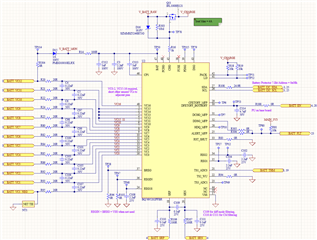Other Parts Discussed in Thread: BQSTUDIO,
Tool/software:
Hi TI Team,
We are experiencing battery failures when leaving batteries plugged into boards that use the BQ7695202PFBR IC. The boards are not turned on, but the protector ICs are powered from the sense connectors of the battery packs. We are using 12S1P LiPo battery packs, and we have observed the following two failure modes:
- One cell is completely depleted at 0.000V, while the other cells are imbalanced.
- All cells are imbalanced and depleted to around 2V.
Below are the cell voltages from two battery packs. The first pack illustrates the first failure mode, and the second pack illustrates the second failure mode.
Battery 1:
|
Cell |
Voltage (V) |
|
1 |
3.712 |
|
2 |
3.380 |
|
3 |
3.711 |
|
4 |
3.213 |
|
5 |
0.000 |
|
6 |
3.704 |
|
7 |
3.613 |
|
8 |
3.694 |
|
9 |
3.689 |
|
10 |
3.694 |
|
11 |
3.710 |
|
12 |
3.719 |
Battery 2:
|
Cell |
Voltage (V) |
|
1 |
1.048 |
|
2 |
2.197 |
|
3 |
1.631 |
|
4 |
2.188 |
|
5 |
2.320 |
|
6 |
1.781 |
|
7 |
2.174 |
|
8 |
2.272 |
|
9 |
2.095 |
|
10 |
2.259 |
|
11 |
1.807 |
|
12 |
1.391 |
Here is our circuit. I have also attached an Excel sheet that captures our device configuration.

BQ76952 Protector Setting Configuration.xlsx
I tried to reproduce the issue by leaving a battery plugged in for 18 hours and logging the cell voltages using BQStudio. The board was not turned on (i.e., only the protector IC was powered), and I had purposely only discharged cell 6 to 4V. Below is the graph from the test.

Here are three key observations from the 18-hour test:
- While I was not able to reproduce the issue, I found that the IC was not able to balance the cells to a delta of 10mV even though Settings:Cell Balancing Config:Cell Balance Stop Delta (Relax) is set to 10mV.
- BQStudio reported that the IC was in sleep mode, so the current consumption should have been in the microamp range. However, I measured a 648mV drop across R14, indicating a current draw of 6.48mA.
- Even though cell 6 is not actively being discharged (i.e., the IC is not PWM-ing the internal discharge FET), I see a constant parasitic draw of about 0.04V / 20Ohms = 2mA. I measured this current by measuring the voltage drop across the 20-Ohm series resistor as well as by using a current probe on the sense wire from the battery pack. Both measurements agreed that there was indeed a constant 2mA draw out of the cell. This is also confirmed by the fact that cell 6's voltage decreases over time (as pictured in the above graph).
Please provide any insights that could help us identify the root cause of these battery failures.
Thanks,
Zaya





